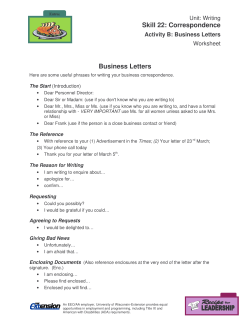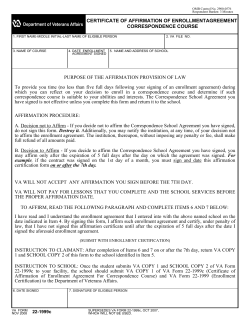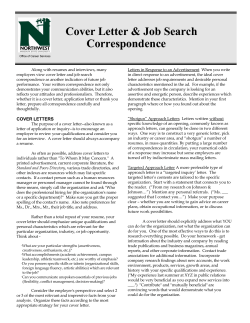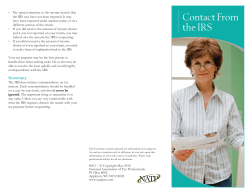
Making a koru design Junior Art Visual Art AR005
AR005 Making a koru design Visual Art Toi Araata Junior Art 2006/1 Visual Art in the New Zealand Curriculum Level 5 The three strands assessed in this unit are: Understanding the visual arts in context Students will investigate the relationship between the production of art works and their social context. Developing ideas Students will generate, develop and refine visual ideas in response to a variety of motivations and a study of selected artists’ works. Practical knowledge Students will apply knowledge of elements and principles for a range of art-making purposes, using conventions and a variety of techniques, tools, materials, processes and procedures. Acknowledgements Every effort has been made to acknowledge and contact copyright holders. The Correspondence School apologises for any omissions and welcomes more accurate information and contact. Gordon Walters, Tamaki, 1983, screenprint AP III, 610 x 455 mm, © Dr Margaret Orbell, The Rutherford Trust. Print and electronic access by permission. Sandy Adsett, Kahurangi, 1988, acrylic on hardboard, 1050 x 1050 mm, Museum of New Zealand, Te Papa Tongarewa, B.041749. Print and electronic access by permission. Images and kowhaiwhai pattern, by Mihiata Retimana, © 2005 The Correspondence School, Wellington, New Zealand. Acknowledgements to The koru & kowhaiwhai: the contemporary renaissance of kowhaiwhai painting, ed. H Kedgley and Porirua Museum, Porirua City, New Zealand: Pataka, 2002. Copyright © 2006 The Correspondence School (TCS), Private Bag 39992, Wellington, New Zealand. All rights reserved. No part of this publication may be reproduced or transmitted in any form or by any means, without the written permission of The Correspondence School. T h e C o r r e s p o ndence School www.correspondence.school.nz Making a koru design In this unit you will: • investigate how the koru motif can be a symbol or a design element in painting • • • • use the koru motif to design a repetitive pattern practise making koru motifs make a template create an original koru design using mixed media. You will need: • • • • • three A4 sheets of cartridge paper an eraser oil pastels scissors cardboard • • • • sellotape newspaper to cover your work space textured surface for a rubbing (optional) paint (optional). When you see complete the activity send your work to your teacher look at the website link follow the helpful tip. AR005 www.correspondence.school.nz The Correspondence School 1 Making a koru design Motif = pattern element or simplified image often repeated. Koru = a representation of a new life form. Some sources say that the curving stalk with its bulb shape resembles the fern frond known as the pitau. The koru may also resemble a curling wave as it crashes against the seashore. The koru shape as an art form/motif/shape has been used by Mãori artists for many generations. It is the most common design element found in kowhaiwhai patterns. Kowhaiwhai pattern A pitau design Kowhaiwhai paintings decorate the ceilings of ancestral houses (whare whakairo) or the walls and ceilings of whare kai (dining halls). Visit this website for more on kowhaiwhai patterns. AR005 www.correspondence.school.nz The Correspondence School 2 Making a koru design Koru can also become a symbol A symbol is a sign or shape that carries a message for the person seeing it. The Correspondence School uses the koru symbol on its notepaper, web pages, envelopes and curriculum booklets for students. This is an earlier Correspondence School design. The koru takes a positive form in black. In the contemporary design the koru motifs are white using the negative space. People see the koru symbol as standing for The Correspondence School. An airline uses a koru symbol on the tail fin of its planes, tickets and baggage labels. AR005 www.correspondence.school.nz The Correspondence School 3 Making a koru design Artists Sandy Adsett, Cliff Whiting, Paratene Matchitt, John Bevan Ford, Robyn Kahukiwa, Buck Nin and Gordon Walters have explored new arrangements of koru shapes in their paintings. Sandy Adsett has explored koru motifs in his art work. He appreciated their simplicity and freedom to ‘push the patterns to their limits’. From his red, black and white palette Adsett explored other colour arrangements. Notice how he placed the koru motifs in grid boxes and repeated, reversed and rotated them. Sandy Adsett Kahurangi 1998 Painting Gordon Walters investigated the use of the koru motif in his art work. He was interested in the repetition of the koru motif in Maori art and changed the motif from a curvilinear form to a strictly geometric shape. Walters has focused on black and white koru with • straight lines • a rounded bulb shape. Notice how the koru motif is repeated in the screen print. Gordon Walters, Tamaki 1983 Screen print AR005 www.correspondence.school.nz The Correspondence School 4 Making a koru design Koru designs The koru motifs have been: • repeated • reversed • arranged in pairs. AR005 www.correspondence.school.nz The Correspondence School 5 Making a koru design Activity 1 Make a list of where you have found the koru motif. AR005 1 As a symbol: 2 As a repetitive pattern: 3 Combined with other motifs to make a painting or design: www.correspondence.school.nz The Correspondence School 6 Making a koru design Activity 2 Making the koru design. You will make your koru design using mixed media. Remember that the meaning of koru is new life. Feel free to use your own ideas. Look at the works of Adsett and Walters and the koru design examples in colour to help you create your koru design. You may have found more examples for activity 1. Step 1 Take an A4 sheet and practise making single koru shapes. Make some koru with longer tails and some with short tails. Choose some single koru and build the double koru by adding another line. AR005 www.correspondence.school.nz The Correspondence School 7 Making a koru design Step 2 Select your best koru and cut out the shape. Place the koru on the cardboard sheet. Draw around it and cut it out to make the template. Template = a pattern which can be traced around to repeat the same shape. The pattern can be reversed to trace shapes in the opposite direction. Step 3 Making a panel Fold an A4 sheet of paper in half lengthwise. Cut along the folded line. Join the short ends with sellotape as shown to make a panel. Step 4 • Take the koru template and plan your design. • • • • You may decide to have a simple repetitive pattern. Reverse the shapes in the second panel. Arrange the koru motif in different ways. Draw around the template with pencil or pastel. Repeat the process until you have filled both panels with koru. Making the koru outlines AR005 www.correspondence.school.nz The Correspondence School 8 Making a koru design Adding colour to the background Decide whether the background will have cool or warm colours to make the finished koru design stand out. Warm colours can be red, crimson, orange and yellow. Cool colours are green and blue. You may decide to use contrasting colours in the background. Instructions for rubbing over a textured surface Use a light coloured pastel to make a rubbing over a rough surface such as cardboard for the under layer. This under layer provides a strong textured pastel surface. lino corrugated card Take the darker pastel and gradually work over the background to make a thick layer of pastel. Step 5 Adding colour to the koru shapes. Take the light coloured pastel to make the first layer of colour and texure. You can make a rubbing for the under layer. Go over the under layer with a darker pastel to make a thick surface. Make the pastel follow the curving shape of the koru and tail. AR005 www.correspondence.school.nz The Correspondence School 9 Making a koru design Step 6 To complete your koru design, take a dark blue or black pastel and draw around each koru shape to make definite edges. • You can add more colour to the koru motifs to make a solid surface. • • Add more colour to the background. • Paint over a section of the koru with light paint. You can make more texture by scratching back the surface layers of pastel with a nail or paper clip. When you have completed your koru design, send your work to your teacher. AR005 www.correspondence.school.nz The Correspondence School 10 Glossary Koru a representation of a new life form. Motif a pattern element or simplified image often repeated. Symbol a sign or shape that carries a message for the person seeing it Template a pattern which can be traced around to make repeats of the same shape, and reversed to trace shapes in the opposite direction. AR005 www.correspondence.school.nz The Correspondence School 11 Assessment Aro matawai Tick the button that’s best for you. with difficulty well very well Your comment I planned and drew my koru motifs. I cut out my template and made the outlines of koru motifs. I completed my koru repeat design combining contrasting colours and media. Teacher comment Developing ideas Level 5 Attempted Succeeded Generate, develop and refine visual ideas. Develops a range of ideas using the koru motif. Develops koru Develops the motifs to make koru motif to a repeat design. create a repeat design using mixed media. Develops the koru motif to create a repeat design using mixed media with skill. Practical knowledge Level 5 Attempted Succeeded Did very well Did an excellent job Understanding art in context. Investigating how the koru motif is linked to the making of art. Finds some koru motifs. Finds the koru motif used as a symbol. Finds the motif used as a symbol and as a repeat design. Finds the koru combined with other motifs in paintings and designs. AR005 www.correspondence.school.nz Did very well Did an excellent job The Correspondence School Cover sheet Return this coversheet attached to your work Students – attach your address label here, otherwise complete the following: Full Name: _________________________________________________________ ID No: ______________________ Address (if changed) ______________________________________________________________________________ Phone No. (if changed): _______________________________ Fax: _______________________________________ Email: ______________________________________________ @ _________________________________________ For Correspondence School use only Name in full Mail point Student assessment Internal address label here AR005 AR005 Initials Date
© Copyright 2025










